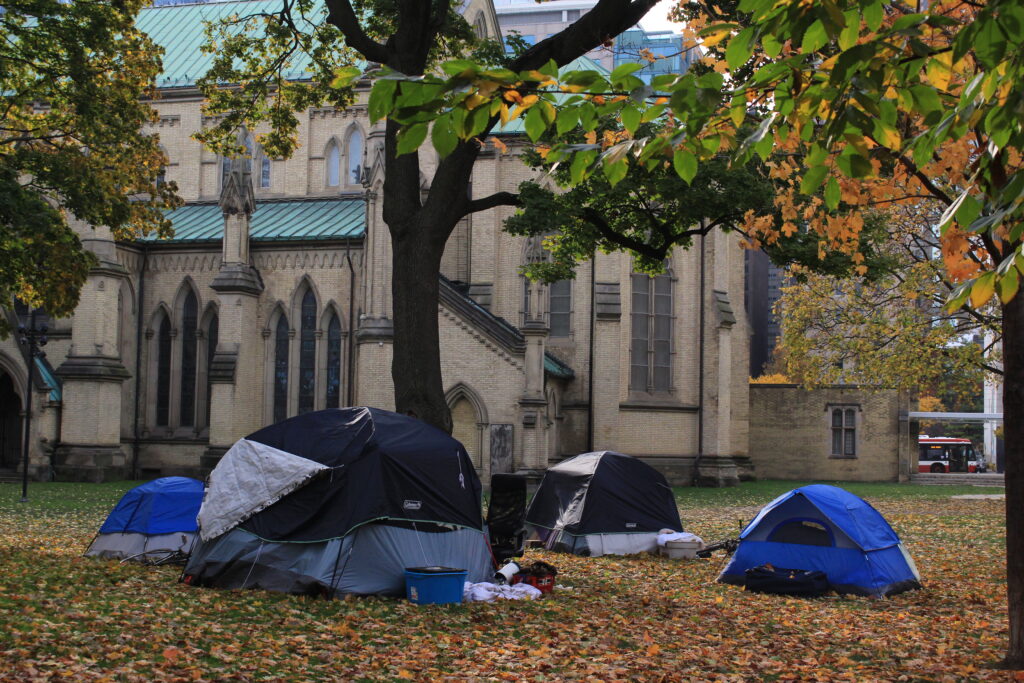
Listen to the whole story here:
The temperature is expected to hit zero overnight this week, putting a spotlight on the fact that Toronto doesn’t have enough shelter space to keep unhoused Torontonians warm this winter.
The city introduced its Winter Services Plan last week, announcing plans to add 530 spaces to existing shelters, as well as 218 spaces across four warming centres.
The city said it will also open three temporary 24-hour respite sites, which will be made available from Nov. 15 to April 15. Unlike warming centres, which open when the temperature drops below -5 C and during federal winter weather warnings, the respite sites will be open for the duration of the season.
When the temperature reaches -15 C or lower, the city says it will open an additional warming shelter, as well as 164 shelter spaces for surge capacity. Outreach teams will hit the streets to hand out blankets, sleeping bags and winter clothing, the city says, and to encourage unhoused individuals to shelter indoors.
The city also expects to open up to 286 new social housing units and 100 spaces in refugee houses this season — but it still it won’t be enough.
“Seasonal plans cannot fully address the increasing demand for shelter,” the city said in a news release.
Toronto’s battered shelter system is already struggling to meet the needs of more than 12,200 people currently staying in its shelters and city-funded hotel rooms, more than half of whom the city says are refugee claimants. As of October, an average of 223 people are turned away nightly due to demand.
Cathy Crowe, a long-term street nurse and homeless advocate, says she’s “appalled” by the lack of support for Toronto’s homeless population.
“After all these years, it’s just become abundantly clear that the city is not recognizing a right to shelter,” said Crowe. “Even though they have the means, they are not taking the steps to ensure that there’s a space for every single person.”
Many of Toronto’s efforts to address the homelessness crisis have been short-term and stop-gap solutions, including sleeping people on TTC buses and in libraries during extreme weather..
While the city says it’s aiming to expand its shelter system with up to 20 new permanent shelters by 2033, the press release and statements from city councillors emphasized the need for long-term solutions from provincial and federal governments like affordable housing and refugee support centres.
“We need the Federal and Provincial Governments to step up as partners and ensure everyone has a safe and secure place to call home, including real commitments to increase deeply affordable housing and supportive housing,” said Coun. Alejandra Bravo in a statement.
Crowe said that the city should be prioritizing shelter space for the homeless and redirecting city budgets rather than waiting for provincial and federal funding.
“Yes, we have to look upstream and prevent more homelessness, but the situation we’ve got right now is dire,” said Crowe. “It’s pretty serious, and we don’t really have a lot of champions on city council.”
On The Record reached out to the mayor’s office but has not yet received a response.
Crowe said part of the problem is the focus on weather-based homelessness advocacy, rather than year-round calls for shelter.
“There is no night through the year that is safe to be outside unless you’re in an encampment in a protected space with others, and you’ve got the measures and means for heat, water and washrooms,” she said.
“There just has to be space year round.”

Carly Pews
Reporter, On the Record, Fall 2024.
This article may have been created with the use of AI tools such as Google Docs, Grammarly, and/or Otter.ai for transcription.
